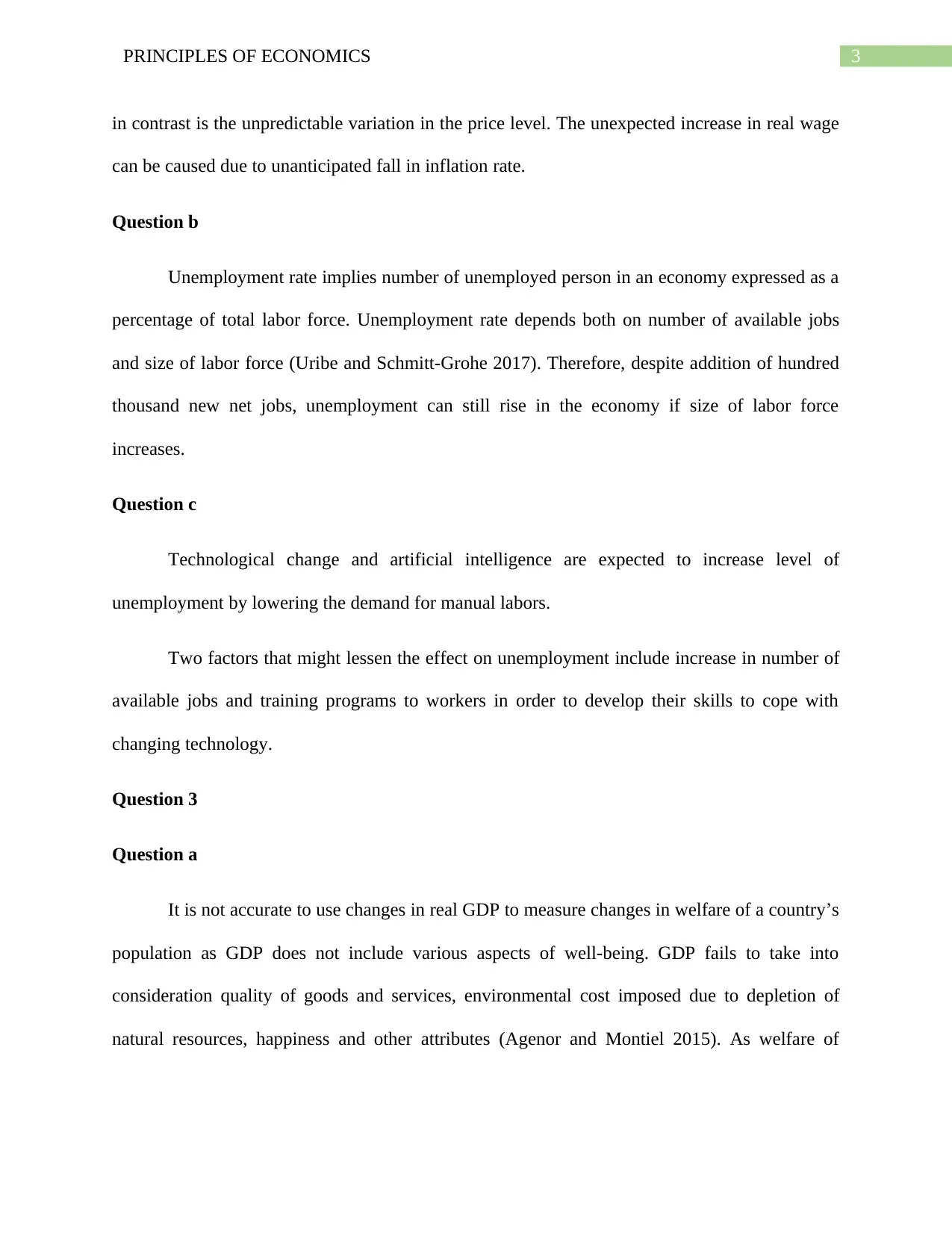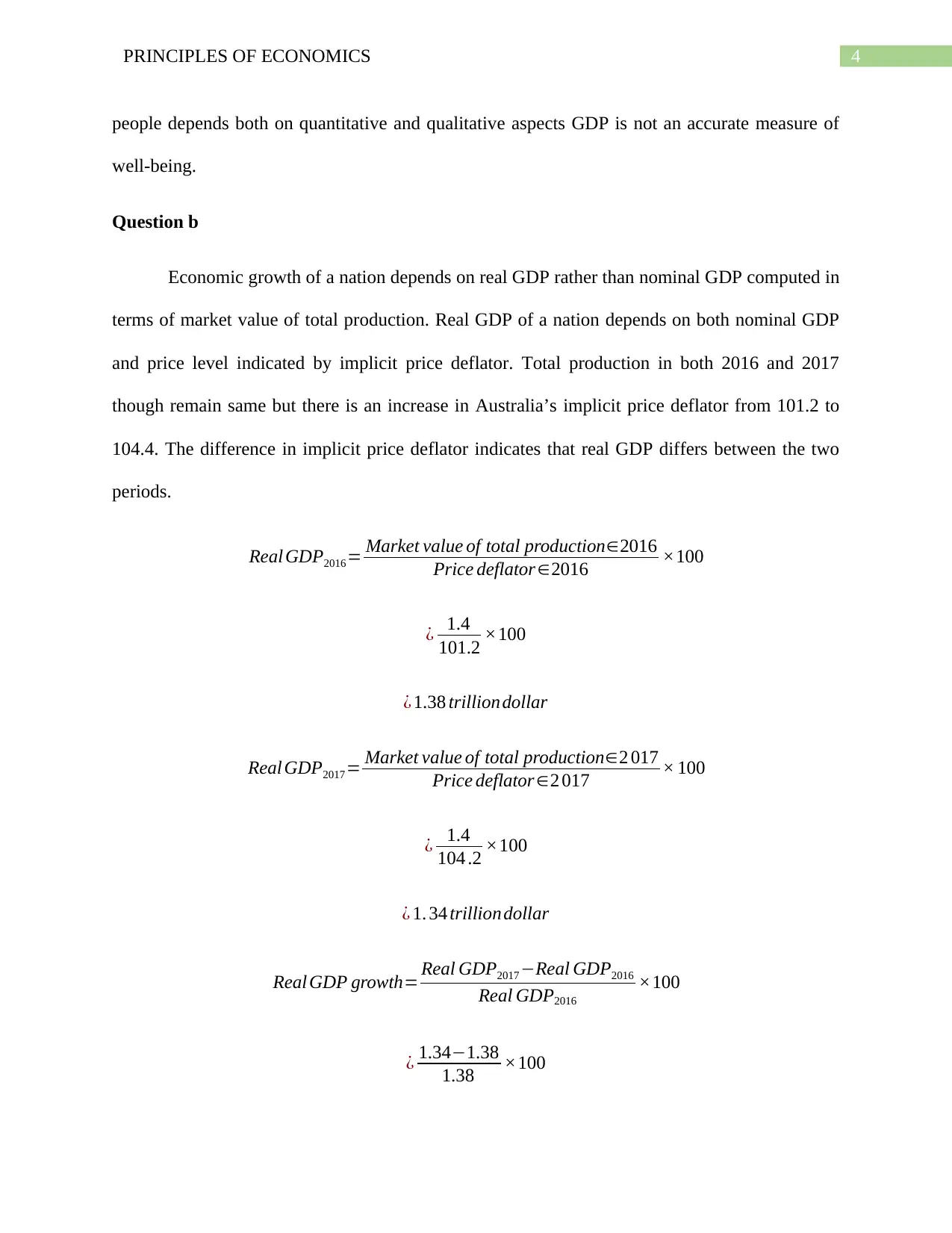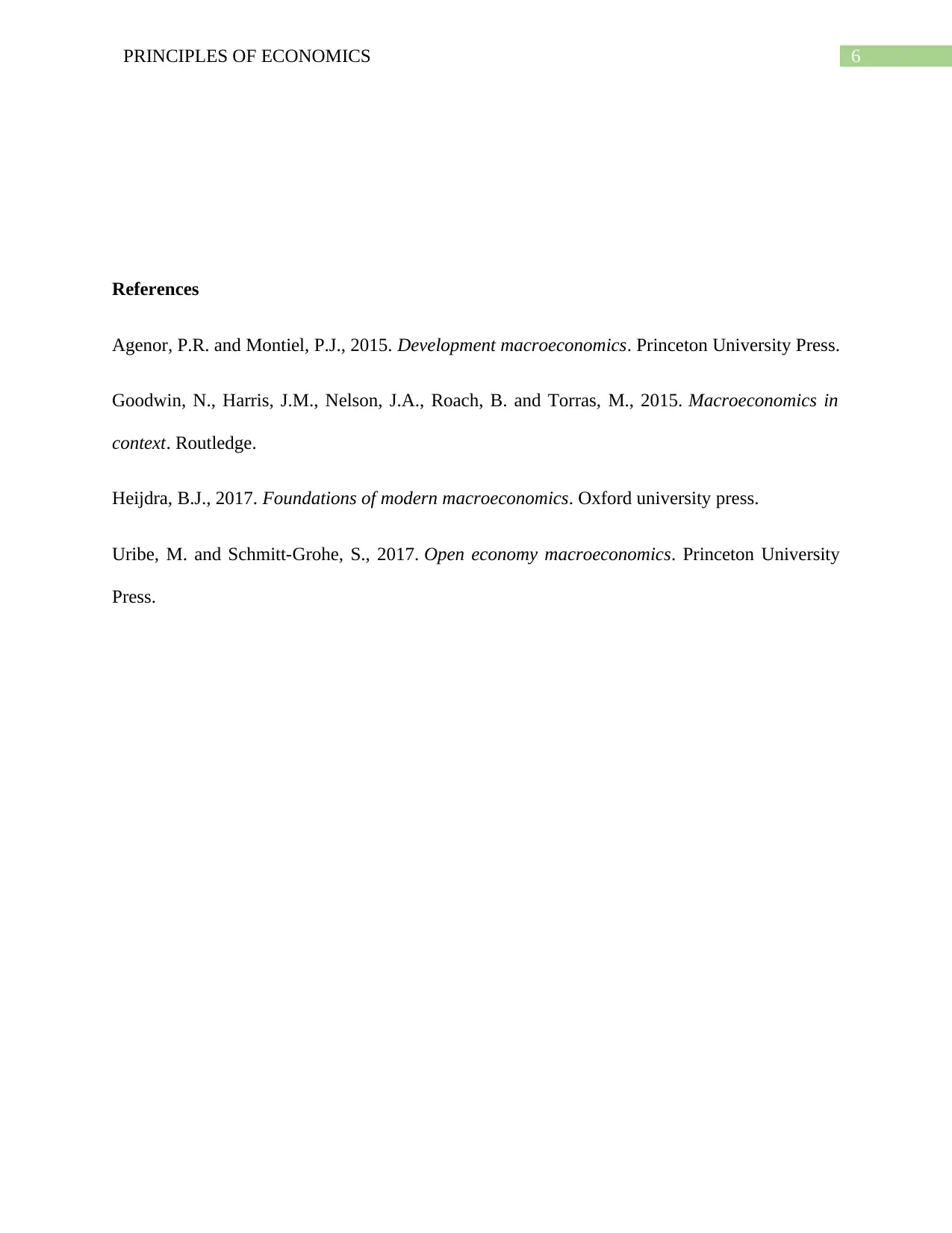University Economics Assignment: Principles of Economics Analysis
VerifiedAdded on 2022/11/22
|7
|895
|359
Homework Assignment
AI Summary
This economics assignment solution addresses key concepts in the principles of economics. It begins with an application of game theory using a business model, analyzing strategic decision-making. The solution then explores nominal and real income, inflation, and unemployment rates, discussing factors that influence them. Furthermore, the assignment evaluates the use of real GDP as a measure of welfare and economic growth, comparing nominal and real GDP. Finally, it examines the phases of the business cycle and differentiates between money and credit cards. The solution incorporates relevant economic concepts and provides a comprehensive analysis of the given questions.

Running head: PRINCIPLES OF ECONOMICS
Principles of Economics
Name of the Student
Name of the University
Course ID
Principles of Economics
Name of the Student
Name of the University
Course ID
Paraphrase This Document
Need a fresh take? Get an instant paraphrase of this document with our AI Paraphraser

1PRINCIPLES OF ECONOMICS
Table of Contents
Question 1........................................................................................................................................2
Question 2........................................................................................................................................2
Question a....................................................................................................................................2
Question b....................................................................................................................................3
Question c....................................................................................................................................3
Question 3........................................................................................................................................3
Question a....................................................................................................................................3
Question b....................................................................................................................................3
Question 4........................................................................................................................................5
Question a....................................................................................................................................5
Question b....................................................................................................................................5
References........................................................................................................................................6
Table of Contents
Question 1........................................................................................................................................2
Question 2........................................................................................................................................2
Question a....................................................................................................................................2
Question b....................................................................................................................................3
Question c....................................................................................................................................3
Question 3........................................................................................................................................3
Question a....................................................................................................................................3
Question b....................................................................................................................................3
Question 4........................................................................................................................................5
Question a....................................................................................................................................5
Question b....................................................................................................................................5
References........................................................................................................................................6

2PRINCIPLES OF ECONOMICS
Question 1
One important application of game theory in strategic decision making can be explained
using a business model. The table below represents a simple matrix consisting various strategies
of a business (Goodwin et al. 2015). The row indicates available strategies and associated pay
off for a particular business and the column indicates corresponding strategies and pay off for its
rival. Both players have two strategies – advertise and does not advertise. The optimum strategy
for both is to choose to advertise and enjoy a pay-off of (4, 4).
Table 1: Game theory matrix
Rival Firm
Advertise Does not
advertise
ABC
Computer
Advertise 4,4 5, -5
Does not
advertise 5, 5 6, 6
Question 2
Question a
Nominal income refers to the income expressed as in absolute monetary terms. Nominal
income is actually measured in terms of current dollar. The purchasing power of people in the
economy however depends on real income which is nominal income adjusted for inflation. Rate
of inflation in contrast is of two types- anticipated inflation and unanticipated inflation.
Anticipated inflation is the predicted or expected increase in price level. Unanticipated inflation
Question 1
One important application of game theory in strategic decision making can be explained
using a business model. The table below represents a simple matrix consisting various strategies
of a business (Goodwin et al. 2015). The row indicates available strategies and associated pay
off for a particular business and the column indicates corresponding strategies and pay off for its
rival. Both players have two strategies – advertise and does not advertise. The optimum strategy
for both is to choose to advertise and enjoy a pay-off of (4, 4).
Table 1: Game theory matrix
Rival Firm
Advertise Does not
advertise
ABC
Computer
Advertise 4,4 5, -5
Does not
advertise 5, 5 6, 6
Question 2
Question a
Nominal income refers to the income expressed as in absolute monetary terms. Nominal
income is actually measured in terms of current dollar. The purchasing power of people in the
economy however depends on real income which is nominal income adjusted for inflation. Rate
of inflation in contrast is of two types- anticipated inflation and unanticipated inflation.
Anticipated inflation is the predicted or expected increase in price level. Unanticipated inflation
⊘ This is a preview!⊘
Do you want full access?
Subscribe today to unlock all pages.

Trusted by 1+ million students worldwide

3PRINCIPLES OF ECONOMICS
in contrast is the unpredictable variation in the price level. The unexpected increase in real wage
can be caused due to unanticipated fall in inflation rate.
Question b
Unemployment rate implies number of unemployed person in an economy expressed as a
percentage of total labor force. Unemployment rate depends both on number of available jobs
and size of labor force (Uribe and Schmitt-Grohe 2017). Therefore, despite addition of hundred
thousand new net jobs, unemployment can still rise in the economy if size of labor force
increases.
Question c
Technological change and artificial intelligence are expected to increase level of
unemployment by lowering the demand for manual labors.
Two factors that might lessen the effect on unemployment include increase in number of
available jobs and training programs to workers in order to develop their skills to cope with
changing technology.
Question 3
Question a
It is not accurate to use changes in real GDP to measure changes in welfare of a country’s
population as GDP does not include various aspects of well-being. GDP fails to take into
consideration quality of goods and services, environmental cost imposed due to depletion of
natural resources, happiness and other attributes (Agenor and Montiel 2015). As welfare of
in contrast is the unpredictable variation in the price level. The unexpected increase in real wage
can be caused due to unanticipated fall in inflation rate.
Question b
Unemployment rate implies number of unemployed person in an economy expressed as a
percentage of total labor force. Unemployment rate depends both on number of available jobs
and size of labor force (Uribe and Schmitt-Grohe 2017). Therefore, despite addition of hundred
thousand new net jobs, unemployment can still rise in the economy if size of labor force
increases.
Question c
Technological change and artificial intelligence are expected to increase level of
unemployment by lowering the demand for manual labors.
Two factors that might lessen the effect on unemployment include increase in number of
available jobs and training programs to workers in order to develop their skills to cope with
changing technology.
Question 3
Question a
It is not accurate to use changes in real GDP to measure changes in welfare of a country’s
population as GDP does not include various aspects of well-being. GDP fails to take into
consideration quality of goods and services, environmental cost imposed due to depletion of
natural resources, happiness and other attributes (Agenor and Montiel 2015). As welfare of
Paraphrase This Document
Need a fresh take? Get an instant paraphrase of this document with our AI Paraphraser

4PRINCIPLES OF ECONOMICS
people depends both on quantitative and qualitative aspects GDP is not an accurate measure of
well-being.
Question b
Economic growth of a nation depends on real GDP rather than nominal GDP computed in
terms of market value of total production. Real GDP of a nation depends on both nominal GDP
and price level indicated by implicit price deflator. Total production in both 2016 and 2017
though remain same but there is an increase in Australia’s implicit price deflator from 101.2 to
104.4. The difference in implicit price deflator indicates that real GDP differs between the two
periods.
Real GDP2016= Market value of total production∈2016
Price deflator∈2016 ×100
¿ 1.4
101.2 ×100
¿ 1.38 trillion dollar
Real GDP2017= Market value of total production∈2 017
Price deflator∈2 017 × 100
¿ 1.4
104 .2 ×100
¿ 1. 34 trillion dollar
Real GDP growth= Real GDP2017−Real GDP2016
Real GDP2016
×100
¿ 1.34−1.38
1.38 ×100
people depends both on quantitative and qualitative aspects GDP is not an accurate measure of
well-being.
Question b
Economic growth of a nation depends on real GDP rather than nominal GDP computed in
terms of market value of total production. Real GDP of a nation depends on both nominal GDP
and price level indicated by implicit price deflator. Total production in both 2016 and 2017
though remain same but there is an increase in Australia’s implicit price deflator from 101.2 to
104.4. The difference in implicit price deflator indicates that real GDP differs between the two
periods.
Real GDP2016= Market value of total production∈2016
Price deflator∈2016 ×100
¿ 1.4
101.2 ×100
¿ 1.38 trillion dollar
Real GDP2017= Market value of total production∈2 017
Price deflator∈2 017 × 100
¿ 1.4
104 .2 ×100
¿ 1. 34 trillion dollar
Real GDP growth= Real GDP2017−Real GDP2016
Real GDP2016
×100
¿ 1.34−1.38
1.38 ×100

5PRINCIPLES OF ECONOMICS
¿ −0.04
1.38 ×100
¿−2.90 %
Economic growth of Australia therefore declined by 2.90 percent between 2016 and 2017. The
statement therefore is not factually correct.
Question 4
Question a
There are four different phases of business cycle each explaining specific characteristics
of the economy. The sales of car will most likely to increase when economy reaches to the phase
of business cycle expansion and economic boom. During this phase, the economy experiences
maximum growth, highest employment growth and is characterized by other positive aspects of
the economy. In contrast, sale will be lowest when the economy experiences a recession and
finally reaches to economic trough (Heijdra 2017). During this time economic growth slows
down, output contracts and unemployment increases indicating an overall economic downturn.
Question b
Money in economic terms is defined a legal tender that is issued officially that consists of
coins and currency and can be directly used as a medium of exchange. Credit cards on the other
hand indicates an overdraft or limit imposed on card users up to which an individual can take a
loan. Credit cards therefore are used only as a medium for taking loan rather than itself being a
legal tender. Hence, credit cards are not considered as money.
¿ −0.04
1.38 ×100
¿−2.90 %
Economic growth of Australia therefore declined by 2.90 percent between 2016 and 2017. The
statement therefore is not factually correct.
Question 4
Question a
There are four different phases of business cycle each explaining specific characteristics
of the economy. The sales of car will most likely to increase when economy reaches to the phase
of business cycle expansion and economic boom. During this phase, the economy experiences
maximum growth, highest employment growth and is characterized by other positive aspects of
the economy. In contrast, sale will be lowest when the economy experiences a recession and
finally reaches to economic trough (Heijdra 2017). During this time economic growth slows
down, output contracts and unemployment increases indicating an overall economic downturn.
Question b
Money in economic terms is defined a legal tender that is issued officially that consists of
coins and currency and can be directly used as a medium of exchange. Credit cards on the other
hand indicates an overdraft or limit imposed on card users up to which an individual can take a
loan. Credit cards therefore are used only as a medium for taking loan rather than itself being a
legal tender. Hence, credit cards are not considered as money.
⊘ This is a preview!⊘
Do you want full access?
Subscribe today to unlock all pages.

Trusted by 1+ million students worldwide

6PRINCIPLES OF ECONOMICS
References
Agenor, P.R. and Montiel, P.J., 2015. Development macroeconomics. Princeton University Press.
Goodwin, N., Harris, J.M., Nelson, J.A., Roach, B. and Torras, M., 2015. Macroeconomics in
context. Routledge.
Heijdra, B.J., 2017. Foundations of modern macroeconomics. Oxford university press.
Uribe, M. and Schmitt-Grohe, S., 2017. Open economy macroeconomics. Princeton University
Press.
References
Agenor, P.R. and Montiel, P.J., 2015. Development macroeconomics. Princeton University Press.
Goodwin, N., Harris, J.M., Nelson, J.A., Roach, B. and Torras, M., 2015. Macroeconomics in
context. Routledge.
Heijdra, B.J., 2017. Foundations of modern macroeconomics. Oxford university press.
Uribe, M. and Schmitt-Grohe, S., 2017. Open economy macroeconomics. Princeton University
Press.
1 out of 7
Related Documents
Your All-in-One AI-Powered Toolkit for Academic Success.
+13062052269
info@desklib.com
Available 24*7 on WhatsApp / Email
![[object Object]](/_next/static/media/star-bottom.7253800d.svg)
Unlock your academic potential
Copyright © 2020–2025 A2Z Services. All Rights Reserved. Developed and managed by ZUCOL.




